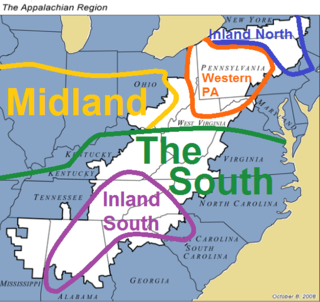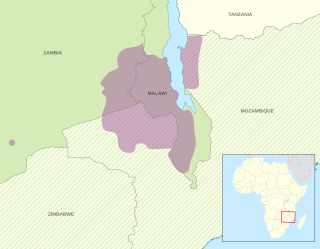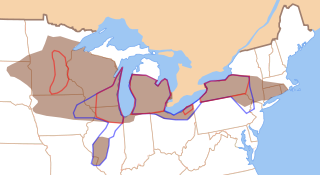American English, sometimes called United States English or U.S. English, is the set of varieties of the English language native to the United States. English is the most widely spoken language in the United States and in most circumstances is the de facto common language used in government, education and commerce. It is also the official language of most U.S. states. Since the late 20th century, American English has become the most influential form of English worldwide.
North American English is the most generalized variety of the English language as spoken in the United States and Canada. Because of their related histories and cultures, plus the similarities between the pronunciations (accents), vocabulary, and grammar of American English and Canadian English, the two spoken varieties are often grouped together under a single category. Canadians are generally tolerant of both British and American spellings, with British spellings of certain words preferred in more formal settings and in Canadian print media; for some other words the American spelling prevails over the British.

Western Pennsylvania English, known more narrowly as Pittsburgh English or popularly as Pittsburghese, is a dialect of American English native primarily to the western half of Pennsylvania, centered on the city of Pittsburgh, but potentially appearing in some speakers as far north as Erie County, as far west as Youngstown, Ohio, and as far south as Clarksburg, West Virginia. Commonly associated with the working class of Pittsburgh, users of the dialect are colloquially known as "Yinzers". The dialect is even heard in the town of Hancock, Maryland.

Appalachia is a geographic region located in the central and southern sections of the Appalachian Mountains of the eastern United States. It stretches from the western Catskill Mountains of New York state into Pennsylvania, continuing on through the Blue Ridge Mountains and Great Smoky Mountains into northern Georgia, Alabama, and Mississippi. In 2021, the region was home to an estimated 26.3 million people, of whom roughly 80% were white.

Madí—also known as Jamamadí after one of its dialects, and also Kapaná or Kanamanti (Canamanti)—is an Arawan language spoken by about 1,000 Jamamadi, Banawá, and Jarawara people scattered over Amazonas, Brazil.

Chewa is a Bantu language spoken in Malawi and a recognised minority in Zambia and Mozambique. The noun class prefix chi- is used for languages, so the language is usually called Chichewa and Chinyanja. In Malawi, the name was officially changed from Chinyanja to Chichewa in 1968 at the insistence of President Hastings Kamuzu Banda, and this is still the name most commonly used in Malawi today. In Zambia, the language is generally known as Nyanja or Cinyanja/Chinyanja '(language) of the lake'.
African-American Vernacular English (AAVE) is the variety of English natively spoken, particularly in urban communities, by most working- and middle-class African Americans and some Black Canadians. Having its own unique grammatical, vocabulary, and accent features, AAVE is employed by middle-class Black Americans as the more informal and casual end of a sociolinguistic continuum. However, in formal speaking contexts, speakers tend to switch to more standard English grammar and vocabulary, usually while retaining elements of the non-standard accent. AAVE is widespread throughout the United States, but is not the native dialect of all African Americans, nor are all of its speakers African American.
Southern American English or Southern U.S. English is a regional dialect or collection of dialects of American English spoken throughout the Southern United States, though concentrated increasingly in more rural areas, and spoken primarily by White Southerners. In terms of accent, its most innovative forms include southern varieties of Appalachian English and certain varieties of Texan English. Popularly known in the United States as a Southern accent or simply Southern, Southern American English now comprises the largest American regional accent group by number of speakers. Formal, much more recent terms within American linguistics include "Southern White Vernacular English" and "Rural White Southern English".
There are a variety of pronunciations in modern English and in historical forms of the language for words spelled with the letter ⟨a⟩. Most of these go back to the low vowel of earlier Middle English, which later developed both long and short forms. The sound of the long vowel was altered in the Great Vowel Shift, but later a new long A developed which was not subject to the shift. These processes have produced the main four pronunciations of ⟨a⟩ in present-day English: those found in the words trap, face, father and square. Separate developments have produced additional pronunciations in words like wash, talk and comma.
Philadelphia English or Delaware Valley English is a variety or dialect of American English native to Philadelphia and extending into Philadelphia's metropolitan area throughout the Delaware Valley, including southeastern Pennsylvania, all of South Jersey, counties of northern Delaware, and the northern Eastern Shore of Maryland. Other than Philadelphia and its surrounding counties and arguably Baltimore, the dialect is spoken in cities such as Wilmington, Atlantic City, Camden, Vineland, and Dover. Philadelphia English is one of the best-studied types of English, as Philadelphia's University of Pennsylvania is the home institution of pioneering sociolinguist William Labov. Philadelphia English shares certain features with New York City English and Midland American English, although it remains a distinct dialect of its own. Philadelphia and Baltimore accents together fall under what Labov describes as a single Mid-Atlantic regional dialect or Mid-Atlantic American English.
New England English is, collectively, the various distinct dialects and varieties of American English originating in the New England area. Most of eastern and central New England once spoke the "Yankee dialect", some of whose accent features still remain in Eastern New England today, such as "R-dropping". Accordingly, one linguistic division of New England is into Eastern versus Western New England English, as defined in the 1939 Linguistic Atlas of New England and the 2006 Atlas of North American English (ANAE). The ANAE further argues for a division between Northern versus Southern New England English, especially on the basis of the cot–caught merger and fronting. The ANAE also categorizes the strongest differentiated New England accents into four combinations of the above dichotomies, simply defined as follows:

Hejazi Arabic or Hijazi Arabic (HA), also known as West Arabian Arabic, is a variety of Arabic spoken in the Hejaz region in Saudi Arabia. Strictly speaking, there are two main groups of dialects spoken in the Hejaz region, one by the urban population, originally spoken mainly in the cities of Jeddah, Mecca, Medina and partially in Ta'if and another dialect by the urbanized rural and bedouin populations. However, the term most often applies to the urban variety which is discussed in this article.

English is a West Germanic language in the Indo-European language family, whose speakers, called Anglophones, originated in early medieval England. The namesake of the language is the Angles, one of the ancient Germanic peoples that migrated to the island of Great Britain.
Older Southern American English is a diverse set of American English dialects of the Southern United States spoken most widely up until the American Civil War of the 1860s, before gradually transforming among its White speakers, first, by the turn of the 20th century, and, again, following the Great Depression, World War II, and, finally, the Civil Rights Movement. By the mid-20th century, among White Southerners, these local dialects had largely consolidated into, or been replaced by, a more regionally unified Southern American English. Meanwhile, among Black Southerners, these dialects transformed into a fairly stable African-American Vernacular English, now spoken nationwide among Black people. Certain features unique to older Southern U.S. English persist today, like non-rhoticity, though typically only among Black speakers or among very localized White speakers.
Chippewa is an Algonquian language spoken from upper Michigan westward to North Dakota in the United States. It represents the southern component of the Ojibwe language.

Midland American English is a regional dialect or super-dialect of American English, geographically lying between the traditionally-defined Northern and Southern United States. The boundaries of Midland American English are not entirely clear, being revised and reduced by linguists due to definitional changes and several Midland sub-regions undergoing rapid and diverging pronunciation shifts since the early-middle 20th century onwards.

Northern American English or Northern U.S. English is a class of historically related American English dialects, spoken by predominantly white Americans, in much of the Great Lakes region and some of the Northeast region within the United States. The North as a super-dialect region is best documented by the 2006 Atlas of North American English (ANAE) in the greater metropolitan areas of Connecticut, Western Massachusetts, Western and Central New York, Northwestern New Jersey, Northeastern Pennsylvania, Northern Ohio, Northern Indiana, Northern Illinois, Northeastern Nebraska, and Eastern South Dakota, plus among certain demographics or areas within Michigan, Wisconsin, Minnesota, Vermont, and New York's Hudson Valley. The ANAE describes that the North, at its core, consists of the Inland Northern dialect and Southwestern New England dialect.
Our Southern Highlanders: A Narrative of Adventure in the Southern Appalachians and a Study of Life Among the Mountaineers is a book written by American author Horace Kephart (1862–1931), first published in 1913 and revised in 1922. Inspired by the years Kephart spent among the inhabitants of the remote Hazel Creek region of the Great Smoky Mountains, the book provides one of the earliest realistic portrayals of life in the rural Appalachian Mountains and one of the first serious analyses of Appalachian culture. While modern historians and writers have criticized Our Southern Highlanders for focusing too much on sensationalistic aspects of mountain culture, the book was an important departure from the previous century's local color writings and their negative distortions of mountain people.
Texan English is the array of American English dialects spoken in Texas, primarily falling under Southern U.S. English. As one nationwide study states, the typical Texan accent is a "Southern accent with a twist". The "twist" refers to inland Southern U.S., older coastal Southern U.S., and South Midland U.S. accents mixing together, due to Texas's settlement history, as well as some lexical (vocabulary) influences from Mexican Spanish. In fact, there is no single accent that covers all of Texas and few dialect features are unique to Texas alone. The newest and most innovative Southern U.S. accent features are best reported in Lubbock, Odessa, somewhat Houston and variably Dallas, though general features of this same dialect are found throughout the state, with several exceptions: Abilene and somewhat Austin, Corpus Christi, and El Paso appear to align more with Midland U.S. accents than Southern ones.
In the sociolinguistics of the English language, raising or short-a raising is a phenomenon by which the "short a" vowel, the TRAP/BATH vowel, is pronounced with a raising of the tongue. In most American and many Canadian English accents, raising is specifically tensing: a combination of greater raising, fronting, lengthening, and gliding that occurs only in certain words or environments. The most common context for tensing throughout North American English, regardless of dialect, is when this vowel appears before a nasal consonant.








